Ap biology proteins - Study guides, Class notes & Summaries
Looking for the best study guides, study notes and summaries about Ap biology proteins? On this page you'll find 262 study documents about Ap biology proteins.
Page 3 out of 262 results
Sort by
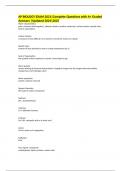
-
AP BIOLOGY EXAM 2021|Complete Questions with A+ Graded Answers |Updated 20242025
- Exam (elaborations) • 28 pages • 2024
-
- $12.59
- + learn more
AP BIOLOGY EXAM 2021|Complete Questions with A+ Graded Answers |Updated 20242025 Water characteristics polar, cohesion (hold together), adhesion (hold to another substance), surface tension, specific heat, heat of vaporization Surface Tension A measure of how difficult it is to stretch or break the surface of a liquid Specific Heat amount of heat absorbed or lost to change temperature by 1C Heat of Vaporization the quantity of heat required to convert 1 from liquid to gas ...
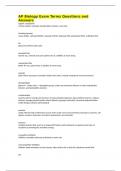
-
AP Biology Exam Terms Questions and Answers
- Exam (elaborations) • 23 pages • 2024
-
- $12.59
- + learn more
AP Biology Exam Terms Questions and Answers organic compounds contain carbon; examples include lipids, proteins, and carbs functional groups amino (NH2), carbonyl (RCOR), carboxyl (COOH), hydroxyl (OH), phosphate (PO4), sulfhydryl (SH) fat glycerol and three fatty acids saturated fats bad for you; animals and some plants have it; solidifies at room temp. unsaturated fats better for you, plants have it; liquifies at room temp. steriods lipids whose structures resem...
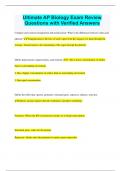
-
Ultimate AP Biology Exam Review Questions with Verified Answers
- Exam (elaborations) • 23 pages • 2024
- Available in package deal
-
- $9.99
- + learn more
Ultimate AP Biology Exam Review Questions with Verified Answers Compare and contrast transpiration and translocation. What is the difference between xylem and phloem? Tranpspiration is the loss of water vapor from the surgace of a plant through the stomata. Translocation is the channeling of the sugar through the phloem. Define hypoosmotic, hyperosmotic, and isomotic 1. Has a lower concentration of solutes than its surrounding enviorment 2. Has a higher concentration of solutes than i...
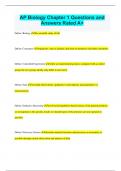
-
AP Biology Chapter 1 Questions and Answers Rated A+
- Exam (elaborations) • 10 pages • 2024
- Available in package deal
-
- $9.99
- + learn more
AP Biology Chapter 1 Questions and Answers Rated A+ Define: Biology the scientific study of life Define: Consumers organisms, such as animals, that feed on producers and other consumers Define: Controlled Experiment where an experimental group is compared with a control group; the two groups ideally only differ in one factor Define: Data recorded observations; qualitative is descriptions and quantitative is measurements Define: Deductive Reasoning involved in hypothesis-based...

-
AP Biology: Cells Latest Version with Complete Solutions
- Exam (elaborations) • 9 pages • 2024
- Available in package deal
-
- $8.99
- + learn more
AP Biology: Cells Latest Version with Complete Solutions Active Transport Movement of solutes against a gradient, requiring the expenditure of energy Adhesion Proteins Attach cells to neighboring cells and give cell stability Anchoring Junctions Protein attachments between adjacent animal cells; desmosomes bind adjacent cells together and are associated with protein filaments that extend into the cell interior to hold structures together Bulk Flow Collective movement of substan...

-
AP Biology Exam Review 2023
- Exam (elaborations) • 45 pages • 2024
- Available in package deal
-
- $12.99
- + learn more
AP Biology Exam Review 2023 Element A pure substance made of only one kind of atom Oxygen A gas produced by plants during photosynthesis that animals use for respiration Nitrogen element found in proteins and nucleic acids trace elements elements required by an organism in only minute quantities Atom Basic unit of matter Protons positively charged subatomic particles Neutrons
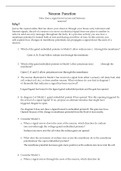
-
AP BIOLOGY NEURON FUNCTION POGIL.
- Exam (elaborations) • 9 pages • 2023
-
- $13.49
- 1x sold
- + learn more
AP BIOLOGY NEURON FUNCTION POGIL.Neuron Function How does a signal travel across and between neurons? Just as the coaxial cables that run down your street or through your house carry television and Internet signals, the job of a neuron is to move an electrical signal from one place to another in order to send sen- sory messages throughout the body. In a previous activity you saw how a membrane potential is formed both at rest and during an inflow of ions. In this activity you will explore...
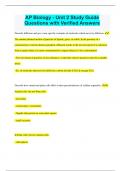
-
AP Biology - Unit 2 Study Guide Questions with Verified Answers
- Exam (elaborations) • 18 pages • 2024
- Available in package deal
-
- $9.99
- + learn more
AP Biology - Unit 2 Study Guide Questions with Verified Answers Describe diffusion and give some specific examples of molecules which move by diffusion. - The random thermal motion of particles of liquids, gases, or solids. In the presence of a concentration or electrochemical gradient, diffusion results in the net movement of a substance from a region where it is more concentrated to a region where it is less concentrated. - The movement of particles of any substance, so that they tend ...

-
AP Biology Exam Review
- Exam (elaborations) • 33 pages • 2024
- Available in package deal
-
- $17.39
- + learn more
AP Biology Exam Review organic compounds - Answer>>contain carbon; examples include lipids, proteins, and carbs functional groups - Answer>>amino (NH2), carbonyl (RCOR), carboxyl (COOH), hydroxyl (OH), phosphate (PO4), sulfhydryl (SH) fat - Answer>>glycerol and three fatty acids saturated fats - Answer>>bad for you; animals and some plants have it; solidifies at room temp. unsaturated fats - Answer>>better for you, plants have it; liquifies at room t...
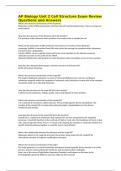
-
AP Biology Unit 2 Cell Structure Exam Review Questions and Answers
- Exam (elaborations) • 14 pages • 2024
- Available in package deal
-
- $10.39
- + learn more
AP Biology Unit 2 Cell Structure Exam Review Questions and Answers What is the structure and function of the ribosome? Ribosomes consist of RNA and proteins and they help with synthesizing proteins. There is a large and small subunit. How does the structure of the ribosome aid in the function? The structure of the ribosome allows proteins to be made inside or outside the cell. What are the three types of RNA involved in the structure or function of the ribosome? messenger (mRNA) is...

Study stress? For sellers on Stuvia, these are actually golden times. KA-CHING! Earn from your study resources too and start uploading now. Discover all about earning on Stuvia


